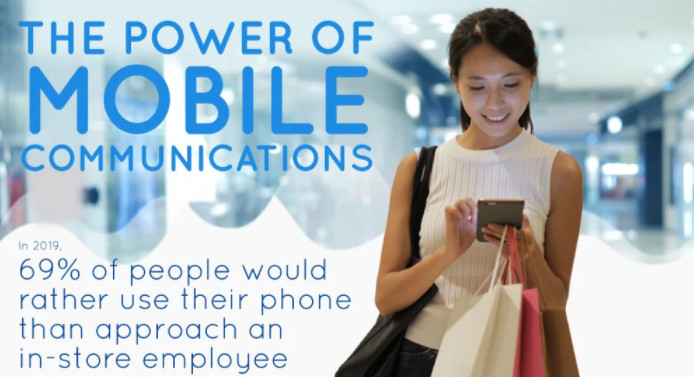Communications
The Power of Mobile Messaging: The Mobile Revolution
For centuries, experts will develop theories as to why homosapiens became “addicted” to phones. Is it the graphics, is it the alternate reality it allows to create? Or is it psychological? Perhaps our co-dependency on technology and mobile devices can be explained by its impression it left us when first unveiled. It’s safe to say the average person assumes technology to be capable of doing most things. Whether it be things we can’t do humanly do, or things we don’t want to do – we assume technology intelligent enough to perform.

It’s okay to admit you’re addicted to your phone. Nearly everyone is. In fact, we’ve reached the point where 69% of people would rather use their phone than get help from an associate when shopping in-store – and that was as of 2019. Since we’re now all quarantining from the coronavirus, mobile communication is more important than ever – having made us completely rework how we engage with tech. Today, consumers want technology to be able to keep up. Here are the latest insights on the direction consumers are steering the mobile economy.
Out With The Old, In With The New
Typically, old habits die hard, but the coronavirus has made it especially easy for us to transition into new norms – specifically with the ways we engage with mobile devices. In 2019, 81% of consumers used mobile to manage their finances, 79% to make online purchases, 32% to access government services, and 10% to receive telehealth care.
Today, a consumers’ primary use of their mobile device is for messaging. 90% of people open a text within 3 minutes. To get more specific, the average person’s open rate for text messages is 98%, and 20% for emails. In other words, a person is 5x more likely to respond to open a text rather than an email. Comparatively, the average response rate for text messages is 45%, 8x higher than the average response rate for emails: 6%. More specifically with that, the average person will respond to a received text message within 90 seconds, 60x higher than the average email response rate of 90 minutes.
With regard to consumers’ personal lives and business, mobile messaging is an essential integrant of modern society. After all, society has been re-modernized following the coronavirus. Nearly every system and process has been reinvented to accommodate the crisis. Reflecting on the rapid course of events, we’ve transitioned into a contact-free economy.
The Contact-Free Economy: Our Tech Reliance Explained
For centuries, experts will develop theories as to why homosapiens became “addicted” to phones. Is it the graphics, is it the alternate reality it allows to create? Or is it psychological? Perhaps our co-dependency on technology and mobile devices can be explained by its impression it left us when first unveiled. It’s safe to say the average person assumes technology to be capable of doing most things. Whether it be things we can’t do humanly, or things we don’t want to do – we assume technology intelligent enough to perform.
Take it from Allan Thygesen, the President of Americas at Google, “When we want something, we expect our phone to tell us where the product is being sold at a store nearby, and even tell us if it’s in stock this very moment. And when we are ready to transact, we expect it to be frictionless and fast.” In other words, we can’t – and don’t want – to be bothered with the tidbits and details of life because technology’s got it. We want the product, we want it now, and we want to get it as quickly as possible. We want communication, we want it now, we send and respond to the message as quickly as possible. Today, phones get the job done, and consumers are clinging onto their devices for dear life.
The Data of the Contact-Free Economy
As Thygesen foreshadowed, consumers want information before they show up in-person. Why? 60% feel more confident and prepared when using mobile. Here’s an example of how that would be performed out.
Curbside pickup has doubled since 2019 due to the pandemic, and 59% of consumers plan to continue using it. In other words, the general consensus has figured out they just prefer having their meal, groceries, or items ready for takeaway upon arrival. As a result, the restaurant and retail industries have booming businesses to the point where 1 in 3 retailers who weren’t offering curbside services at the start of the pandemic are now scrambling to do so. However, restaurants and retailers have still needed to rework their strategies.
Many retailers began accepting orders through real-time, two-way texting or instant messaging with a representative. Others used text messaging to keep customers updated with changing store hours and safety policies. Through many approaches, brands are refocusing marketing strategies from email to SMS, with mobile-only discounts and special offers. GPS tracking allows for customers to “check-in” when they leave home so that staff are ready and waiting when they arrive, and customers can send a message with their location and their vehicle make/model so they can be easily spotted for delivery.
In March 2020, pizza deliveries rose 44% in a single week. Since, 42% of consumers have made plans to increase their online restaurant orders due to quarantine. To accomodate, restaurants are offering texting to keep phone lines open for restaurants to continue taking take-out and delivery orders. Additionally, restaurants have begun posting signs directing customers to text and receive coronavirus information before ever stepping foot inside the restaurant. Consumers are taking the change well. Many feel messaging shows that a company respects their time, makes them more likely to choose that company, and increases the chance they’ll recommend it to others.
What Makes Contactless Exchanges Work?
Around the clock assistance. 2-way messaging is a key feature. Why? 40% of shoppers don’t care if they’re messaging a bot or human being (and 27% can’t tell the difference). 65% of consumers feel more positive toward businesses that offer messaging, so artificially intelligent programmed bots can open time to help consumers with more in-depth concerns as a courtesy.
Society is changing quickly, and technology is proving to keep up well. Check out the visual below for more insights on the power of mobile communication.











